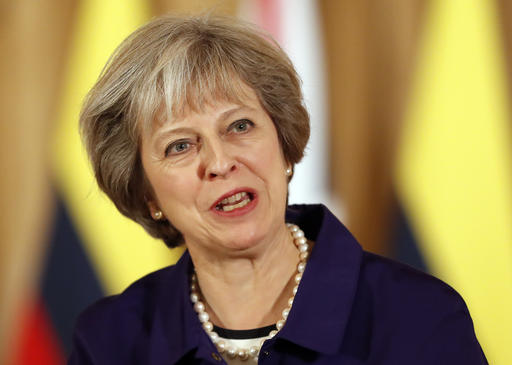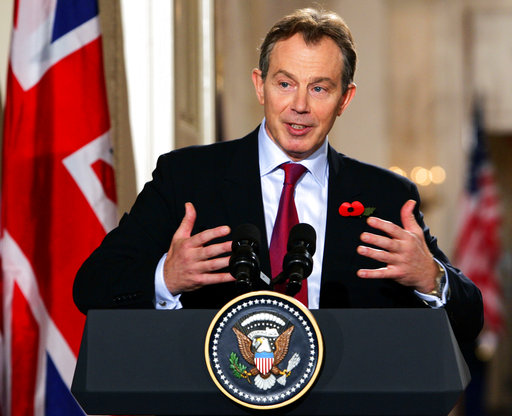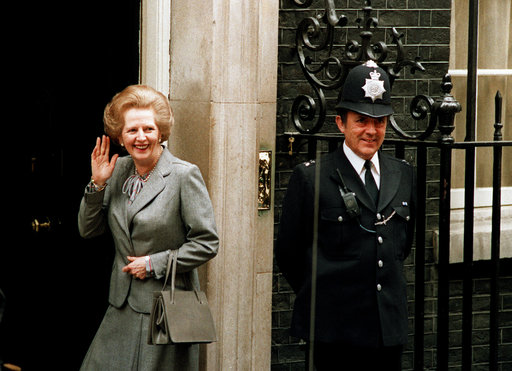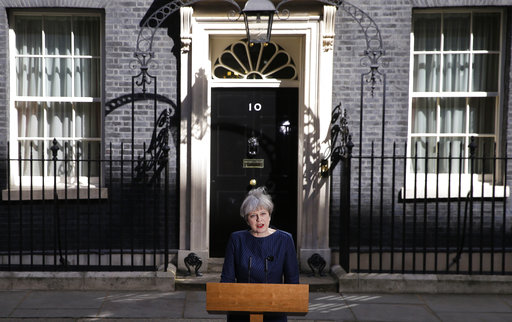British Prime Minister Theresa May has called a general election for June 8. Here’s a brief look at what happens now, and what’s at stake.
WHY DID MAY MAKE HER MOVE?
May took office in July following an internal Conservative leadership contest, after predecessor David Cameron stepped down when voters rejected his call to remain in the EU.
She said that since Britons voted to leave the EU in June, the country had come together, but politicians had not.
“If we do not hold a general election now their political game-playing will continue, and the negotiations with the European Union will reach their most difficult stage in the run-up to the next scheduled election. Division in Westminster will risk our ability to make a success of Brexit and it will cause damaging uncertainty and instability to the country. So we need a general election and we need one now, because we have at this moment a one-off chance to get this done while the European Union agrees its negotiating position and before the detailed talks begin.”
IS IT A DONE DEAL?
British prime ministers used to have the power to call elections at will, but the Fixed-Term Parliaments Act, passed in 2011, makes things more complicated. Under the act, national elections are held every five years, in May. The prime minister can call an early election if two-thirds of lawmakers support it.
May will ask the House of Commons to vote on the snap election on Wednesday. Jeremy Corbyn, leader of the main opposition Labour Party, has said he welcomes an election, meaning the election call will almost certainly pass.
WHAT’S AT STAKE?
Negotiations to leave the EU will be arduous. The talks will deal with money, trade, defense, to name but a few key topics. If May were to gain more seats, she would be able to have more freedom to pursue her own agenda, and to neutralize those inside and outside her own party who disagree with her positions.
HOW DOES IT WORK?
Britain has 650 constituencies from which voters select a local lawmaker. The party with the most lawmakers wins a working majority and is allowed to install its leader as prime minister and implement its manifesto promises.
WHO COULD WIN?
Elections are always unpredictable, but bookmakers consider May’s Conservative Party a strong favorite to win. Opinion polls released last weekend showed the Conservatives with a double-digit lead over the opposition Labour Party, which has been weakened by a split between moderates and left-wing leader Corbyn.
ARE THERE RISKS?
Anytime a leader goes to the people for a vote, there are risks, as Cameron learned to his peril when he lost the vote on Britain’s departure from the EU just over a year after winning re-election.
Read more:
Here is a brief glance of May and her five most recent predecessors:
THERESA MAY
Conservative: 2016-
May took power after the vote to leave the European Union in June of last year after the resignation of former leader David Cameron, who had campaigned to stay in. Her decision Tuesday to call for an early election reflects an effort on her part to shore up her power base before the tough Brexit negotiations ahead. Last month, May formerly triggered the two-year process by which Britain will leave the EU.

This is a Wednesday, Nov. 2, 2016 file photo of Britain’s Prime Minister Theresa May speaks during a press statement with Colombia’s President Juan Manuel Santos at 10 Downing Street in London. (AP Photo/Kirsty Wigglesworth)
DAVID CAMERON
Conservative: 2010-2016
Though his Conservative Party failed to win the 2010 general outright, Cameron led a coalition government with the much-smaller Liberal Democrats that enforced fiscal austerity designed to get Britain’s public finances into shape following the global financial crisis.
His legacy, though, will be his decision to hold the referendum on British membership of the EU that made Brexit possible. Cameron, who promised the referendum in his party’s 2015 election manifesto, campaigned for Britain to remain part of the EU. He stepped down when the country voted to leave.

FILE- In this Monday, June 27, 2016 file photo, the then Britain’s Prime Minister David Cameron leaves 10 Downing Street in London, to address Parliament on Britain’s European Union referendum choice to leave. Cameron, who promised the referendum in his party’s 2015 election manifesto, campaigned for Britain to remain part of the EU. He stepped down when the country voted to leave. (AP Photo/Matt Dunham, File)
GORDON BROWN
Labour: 2007-2010
After 10 years as the country’s finance minister, Brown’s premiership will always be marked out by the global financial crisis and the recession that followed. He bailed out Britain’s banks, and in April 2009, hosted the summit of the Group of 20 leaders in London where world leaders pledged $1.1 trillion to help the world economy through the crisis. They also pledged to improve financial supervision and regulation. Unlike May, Brown failed to call a snap general election to earn his own mandate following Blair’s resignation.

FILE- In this Thursday, April 2, 2009 file photo, the then British Prime Minister Gordon Brown speaks at a press conference at the end of the G20 Summit at the Excel centre in London. Brown’s premiership will always be marked out by the global financial crisis and the recession that followed. (AP Photo/Alastair Grant, File)
TONY BLAIR
Labour: 1997-2007
Blair’s defining moment came in the aftermath of the Sept. 11 attacks in the U.S. His decision to back President George W. Bush in the Iraq war proved hugely controversial, in part because the case for war was built around the idea that Saddam Hussein had weapons of mass destruction. When none were found, Blair faced widespread criticism and his popularity, which saw him lead the Labour Party to three straight election victories, eroded.

FILE- In this Friday, Nov. 12, 2004 file photo, the then Britain’s Prime Minister Tony Blair gestures as he speaks to reporters with President Bush in the East Room of the White House in Washington. In 1997, Blair became the first Labour prime minister in 18 years. His defining moment came in the aftermath of the Sept. 11 terrorist attacks in the United States. (AP Photo/Charles Dharapak, File)
JOHN MAJOR
Conservative: 1990-1997
Major won a surprising victory in the 1992 election in the face of recession, but his party soon descended into internecine squabbling over Britain’s place in Europe. His government may be best-remembered for what it didn’t do: join the euro currency. He also played a key role in starting the Northern Ireland peace process.

FILE- In this Monday March 17, 1997 file photo, the then British Prime Minister John Major calls a national election for May 1 outside of 10 Downing Street. After ten years as the country’s finance minister, Brown’s premiership will always be marked out by the global financial crisis and the recession that followed. (AP Photo/Max Nash, File)
MARGARET THATCHER
Conservative: 1979-1990
Thatcher was Britain’s first female British prime minister and the country’s longest serving leader in more than 150 years. She bolstered her reputation by leading the country to war against Argentina to reclaim the Falkland Islands. Her government followed a radical program of privatization and deregulation that profoundly changed the country. Internationally prominent, she was known for her chummy relationship with President Ronald Reagan and for earning praise from Soviet leader Mikhail Gorbachev.

FILE – In this May 11, 1987 file photo, the then Britain’s Prime Minister Margaret Thatcher waves to members of the media on returning to No. 10 Downing Street from Buckingham Palace after a visit with Queen Elizabeth II. Thatcher was Britain’s first female British prime minister and the country’s longest serving leader for more than 150 years. Her government followed a radical program of privatization and deregulation that profoundly changed the country. (AP Photo/Dennis Redman, File)
 CGTN America
CGTN America
 Britain’s Prime Minister Theresa May speaks to the media outside her official residence of 10 Downing Street in London, Tuesday April 18, 2017. British Prime Minister Theresa May announced she will seek early election on June 8 (AP Photo/Alastair Grant)
Britain’s Prime Minister Theresa May speaks to the media outside her official residence of 10 Downing Street in London, Tuesday April 18, 2017. British Prime Minister Theresa May announced she will seek early election on June 8 (AP Photo/Alastair Grant)
